MAZDA MODEL 6 2005 (in English) Service Manual
Manufacturer: MAZDA, Model Year: 2005, Model line: MODEL 6, Model: MAZDA MODEL 6 2005Pages: 340, PDF Size: 3.73 MB
Page 41 of 340
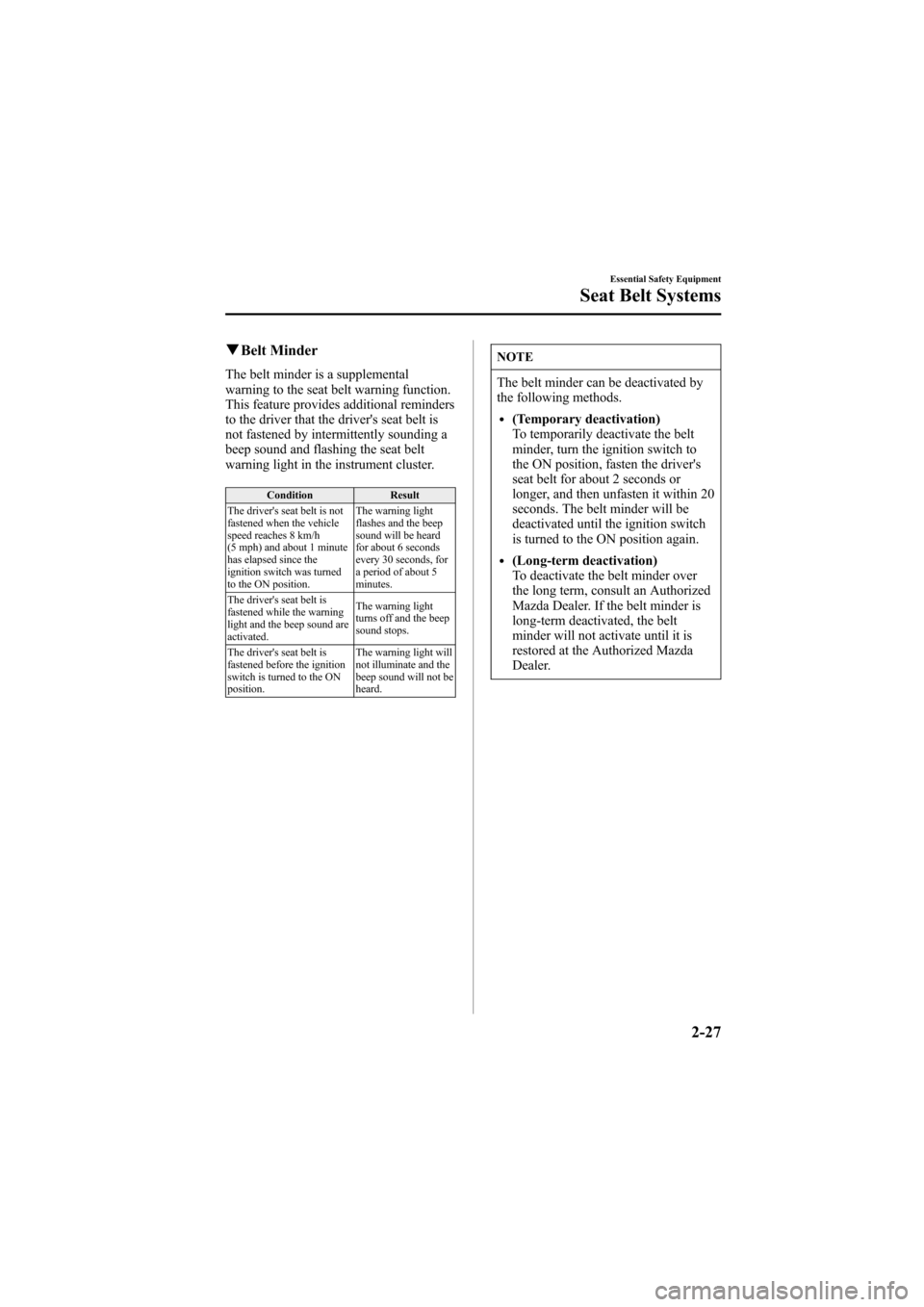
Black plate (41,1)
qBelt Minder
The belt minder is a supplemental
warning to the seat belt warning function.
This feature provides additional reminders
to the driver that the driver's seat belt is
not fastened by intermittently sounding a
beep sound and flashing the seat belt
warning light in the instrument cluster.
Condition Result
The driver's seat belt is not
fastened when the vehicle
speed reaches 8 km/h
(5 mph) and about 1 minute
has elapsed since the
ignition switch was turned
to the ON position.The warning light
flashes and the beep
sound will be heard
for about 6 seconds
every 30 seconds, for
a period of about 5
minutes.
The driver's seat belt is
fastened while the warning
light and the beep sound are
activated.The warning light
turns off and the beep
sound stops.
The driver's seat belt is
fastened before the ignition
switch is turned to the ON
position.The warning light will
not illuminate and the
beep sound will not be
heard.
NOTE
The belt minder can be deactivated by
the following methods.
l(Temporary deactivation)
To temporarily deactivate the belt
minder, turn the ignition switch to
the ON position, fasten the driver's
seat belt for about 2 seconds or
longer, and then unfasten it within 20
seconds. The belt minder will be
deactivated until the ignition switch
is turned to the ON position again.
l(Long-term deactivation)
To deactivate the belt minder over
the long term, consult an Authorized
Mazda Dealer. If the belt minder is
long-term deactivated, the belt
minder will not activate until it is
restored at the Authorized Mazda
Dealer.
Essential Safety Equipment
Seat Belt Systems
2-27
Mazda6_8T56-EC-04G_Edition2 Page41
Monday, November 15 2004 4:32 PM
Form No.8T56-EC-04G
Page 42 of 340
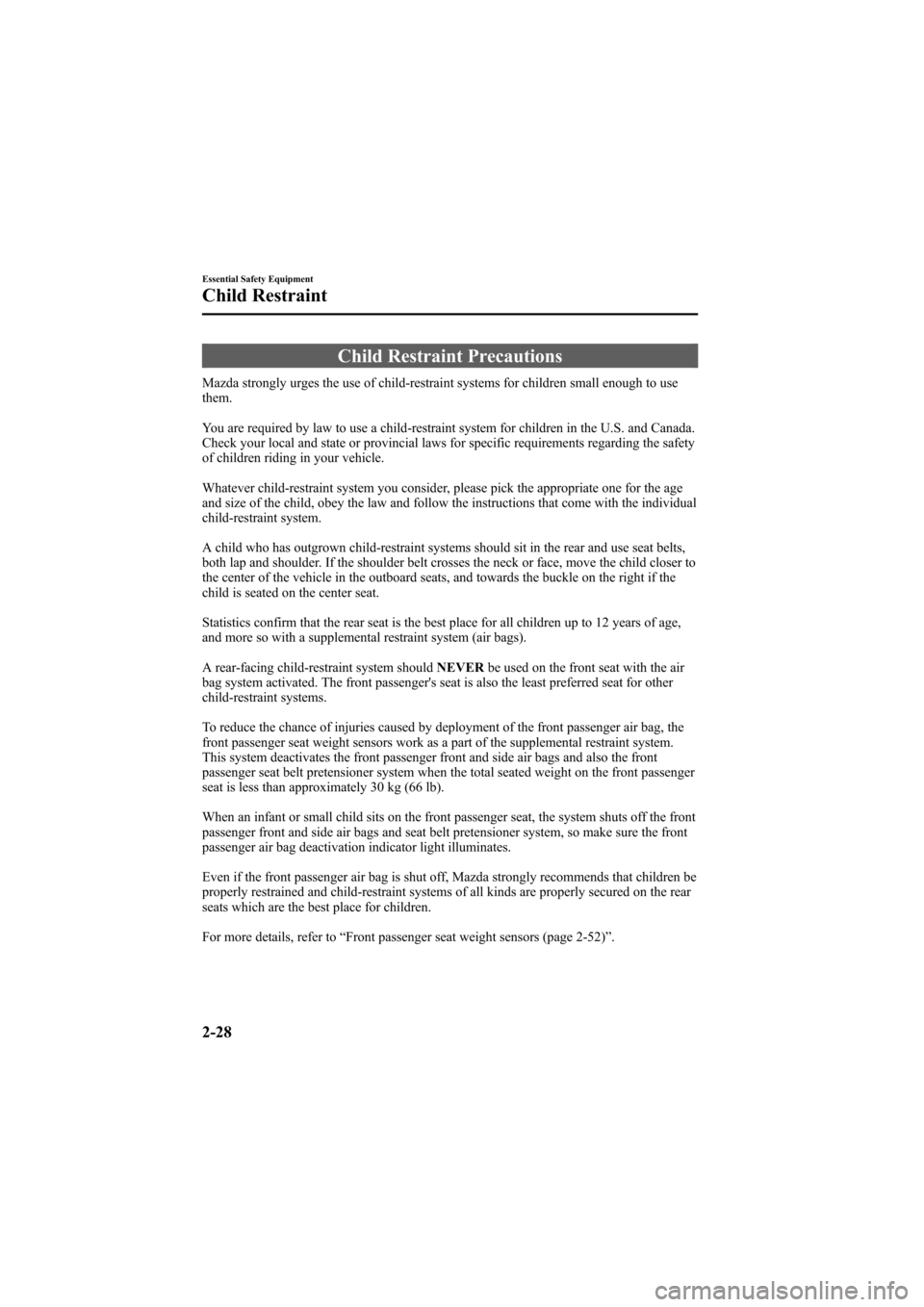
Black plate (42,1)
Child Restraint Precautions
Mazda strongly urges the use of child-restraint systems for children small enough to use
them.
You are required by law to use a child-restraint system for children in the U.S. and Canada.
Check your local and state or provincial laws for specific requirements regarding the safety
of children riding in your vehicle.
Whatever child-restraint system you consider, please pick the appropriate one for the age
and size of the child, obey the law and follow the instructions that come with the individual
child-restraint system.
A child who has outgrown child-restraint systems should sit in the rear and use seat belts,
both lap and shoulder. If the shoulder belt crosses the neck or face, move the child closer to
the center of the vehicle in the outboard seats, and towards the buckle on the right if the
child is seated on the center seat.
Statistics confirm that the rear seat is the best place for all children up to 12 years of age,
and more so with a supplemental restraint system (air bags).
A rear-facing child-restraint system shouldNEVERbe used on the front seat with the air
bag system activated. The front passenger's seat is also the least preferred seat for other
child-restraint systems.
To reduce the chance of injuries caused by deployment of the front passenger air bag, the
front passenger seat weight sensors work as a part of the supplemental restraint system.
This system deactivates the front passenger front and side air bags and also the front
passenger seat belt pretensioner system when the total seated weight on the front passenger
seat is less than approximately 30 kg (66 lb).
When an infant or small child sits on the front passenger seat, the system shuts off the front
passenger front and side air bags and seat belt pretensioner system, so make sure the front
passenger air bag deactivation indicator light illuminates.
Even if the front passenger air bag is shut off, Mazda strongly recommends that children be
properly restrained and child-restraint systems of all kinds are properly secured on the rear
seats which are the best place for children.
For more details, refer to“Front passenger seat weight sensors (page 2-52)”.
2-28
Essential Safety Equipment
Child Restraint
Mazda6_8T56-EC-04G_Edition2 Page42
Monday, November 15 2004 4:32 PM
Form No.8T56-EC-04G
Page 43 of 340
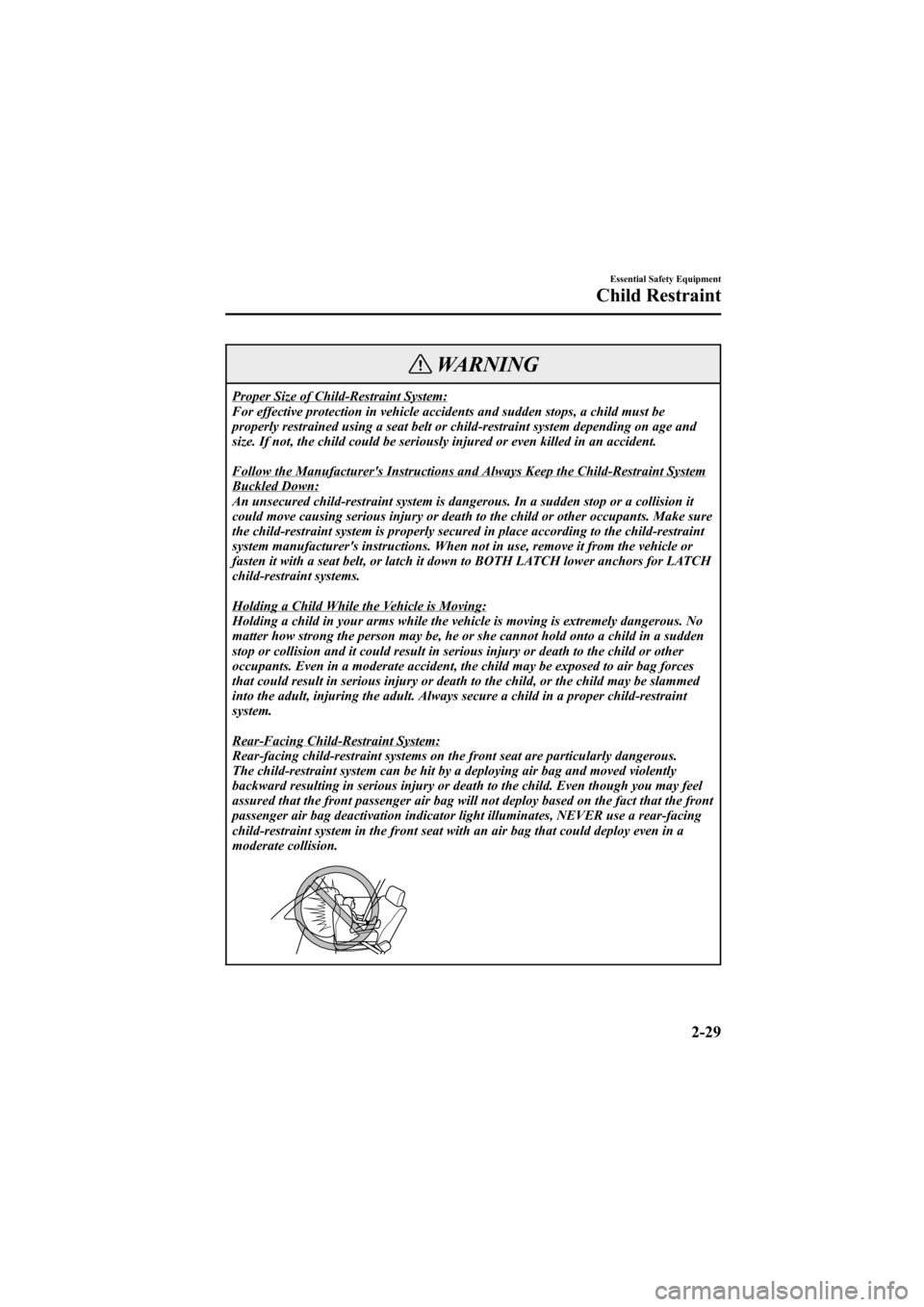
Black plate (43,1)
WARNING
Proper Size of Child-Restraint System:
For effective protection in vehicle accidents and sudden stops, a child must be
properly restrained using a seat belt or child-restraint system depending on age and
size. If not, the child could be seriously injured or even killed in an accident.
Follow the Manufacturer's Instructions and Always Keep the Child-Restraint SystemBuckled Down:
An unsecured child-restraint system is dangerous. In a sudden stop or a collision it
could move causing serious injury or death to the child or other occupants. Make sure
the child-restraint system is properly secured in place according to the child-restraint
system manufacturer's instructions. When not in use, remove it from the vehicle or
fasten it with a seat belt, or latch it down to BOTH LATCH lower anchors for LATCH
child-restraint systems.
Holding a Child While the Vehicle is Moving:
Holding a child in your arms while the vehicle is moving is extremely dangerous. No
matter how strong the person may be, he or she cannot hold onto a child in a sudden
stop or collision and it could result in serious injury or death to the child or other
occupants. Even in a moderate accident, the child may be exposed to air bag forces
that could result in serious injury or death to the child, or the child may be slammed
into the adult, injuring the adult. Always secure a child in a proper child-restraint
system.
Rear-Facing Child-Restraint System:
Rear-facing child-restraint systems on the front seat are particularly dangerous.
The child-restraint system can be hit by a deploying air bag and moved violently
backward resulting in serious injury or death to the child. Even though you may feel
assured that the front passenger air bag will not deploy based on the fact that the front
passenger air bag deactivation indicator light illuminates, NEVER use a rear-facing
child-restraint system in the front seat with an air bag that could deploy even in a
moderate collision.
Essential Safety Equipment
Child Restraint
2-29
Mazda6_8T56-EC-04G_Edition2 Page43
Monday, November 15 2004 4:32 PM
Form No.8T56-EC-04G
Page 44 of 340
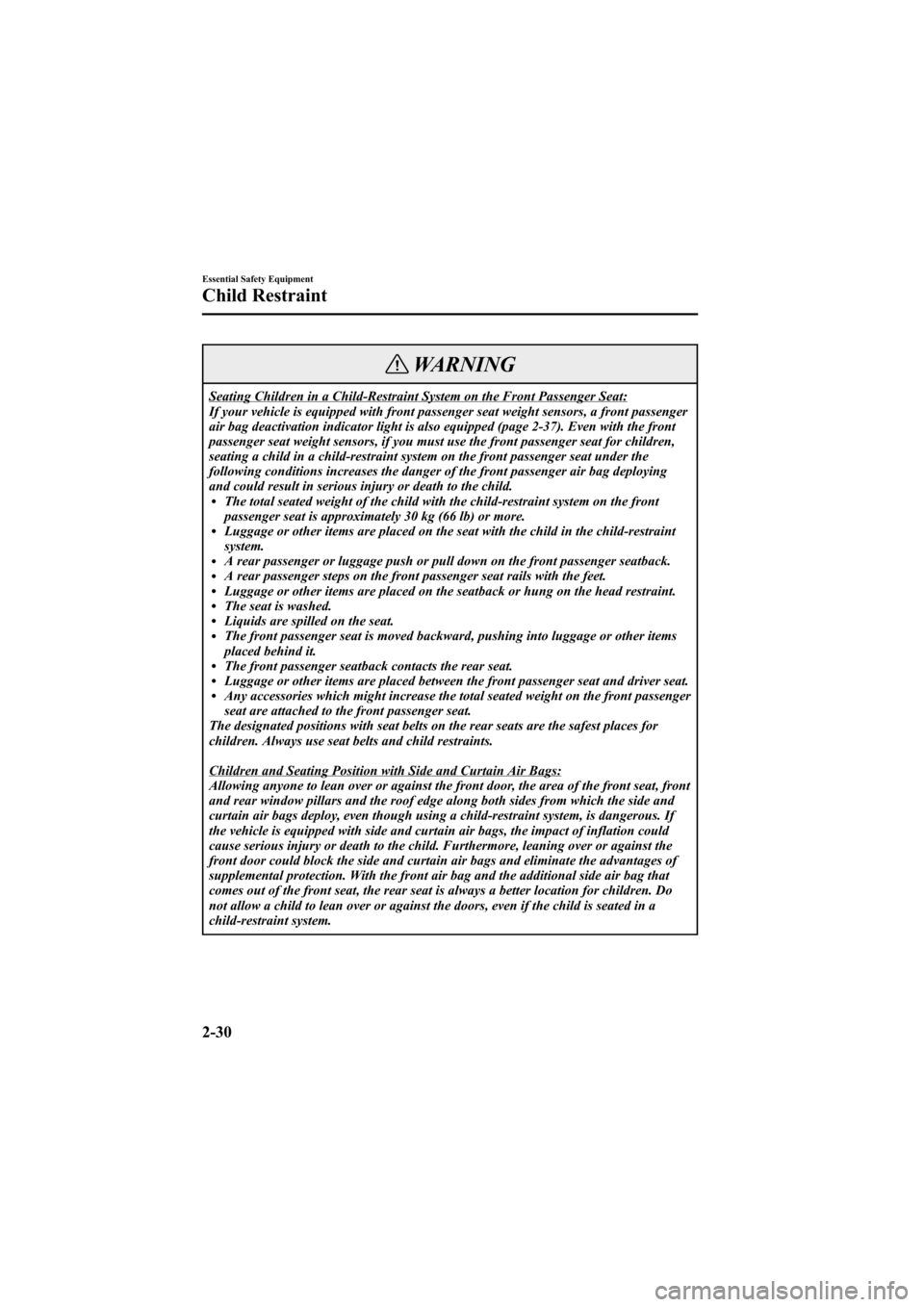
Black plate (44,1)
WARNING
Seating Children in a Child-Restraint System on the Front Passenger Seat:
If your vehicle is equipped with front passenger seat weight sensors, a front passenger
air bag deactivation indicator light is also equipped (page 2-37). Even with the front
passenger seat weight sensors, if you must use the front passenger seat for children,
seating a child in a child-restraint system on the front passenger seat under the
following conditions increases the danger of the front passenger air bag deploying
and could result in serious injury or death to the child.
lThe total seated weight of the child with the child-restraint system on the front
passenger seat is approximately 30 kg (66 lb) or more.
lLuggage or other items are placed on the seat with the child in the child-restraint
system.
lA rear passenger or luggage push or pull down on the front passenger seatback.lA rear passenger steps on the front passenger seat rails with the feet.lLuggage or other items are placed on the seatback or hung on the head restraint.lThe seat is washed.lLiquids are spilled on the seat.lThe front passenger seat is moved backward, pushing into luggage or other items
placed behind it.
lThe front passenger seatback contacts the rear seat.lLuggage or other items are placed between the front passenger seat and driver seat.lAny accessories which might increase the total seated weight on the front passenger
seat are attached to the front passenger seat.
The designated positions with seat belts on the rear seats are the safest places for
children. Always use seat belts and child restraints.
Children and Seating Position with Side and Curtain Air Bags:
Allowing anyone to lean over or against the front door, the area of the front seat, front
and rear window pillars and the roof edge along both sides from which the side and
curtain air bags deploy, even though using a child-restraint system, is dangerous. If
the vehicle is equipped with side and curtain air bags, the impact of inflation could
cause serious injury or death to the child. Furthermore, leaning over or against the
front door could block the side and curtain air bags and eliminate the advantages of
supplemental protection. With the front air bag and the additional side air bag that
comes out of the front seat, the rear seat is always a better location for children. Do
not allow a child to lean over or against the doors, even if the child is seated in a
child-restraint system.
2-30
Essential Safety Equipment
Child Restraint
Mazda6_8T56-EC-04G_Edition2 Page44
Monday, November 15 2004 4:32 PM
Form No.8T56-EC-04G
Page 45 of 340
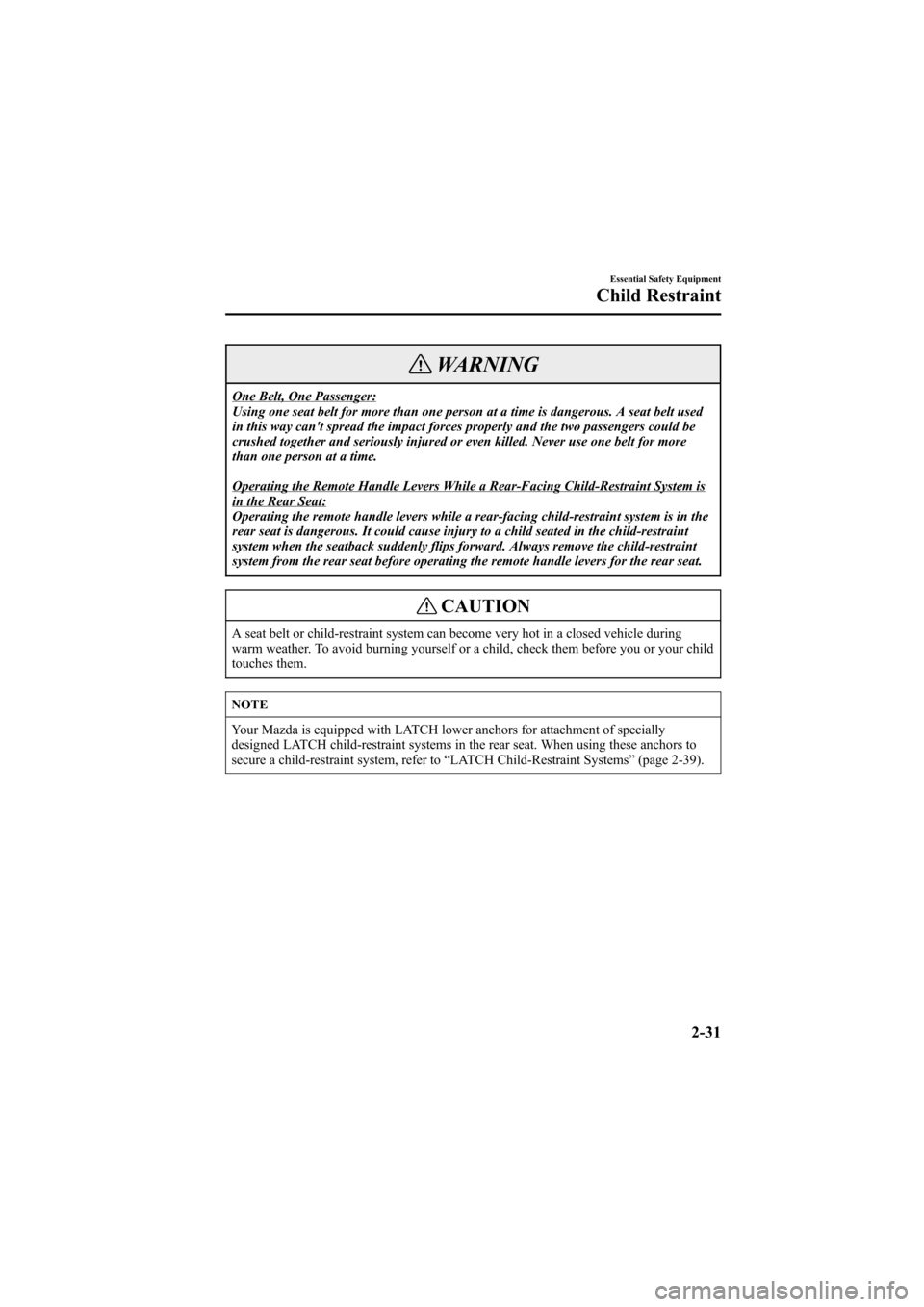
Black plate (45,1)
WARNING
One Belt, One Passenger:
Using one seat belt for more than one person at a time is dangerous. A seat belt used
in this way can't spread the impact forces properly and the two passengers could be
crushed together and seriously injured or even killed. Never use one belt for more
than one person at a time.
Operating the Remote Handle Levers While a Rear-Facing Child-Restraint System isin the Rear Seat:
Operating the remote handle levers while a rear-facing child-restraint system is in the
rear seat is dangerous. It could cause injury to a child seated in the child-restraint
system when the seatback suddenly flips forward. Always remove the child-restraint
system from the rear seat before operating the remote handle levers for the rear seat.
CAUTION
A seat belt or child-restraint system can become very hot in a closed vehicle during
warm weather. To avoid burning yourself or a child, check them before you or your child
touches them.
NOTE
Your Mazda is equipped with LATCH lower anchors for attachment of specially
designed LATCH child-restraint systems in the rear seat. When using these anchors to
secure a child-restraint system, refer to“LATCH Child-Restraint Systems”(page 2-39).
Essential Safety Equipment
Child Restraint
2-31
Mazda6_8T56-EC-04G_Edition2 Page45
Monday, November 15 2004 4:32 PM
Form No.8T56-EC-04G
Page 46 of 340
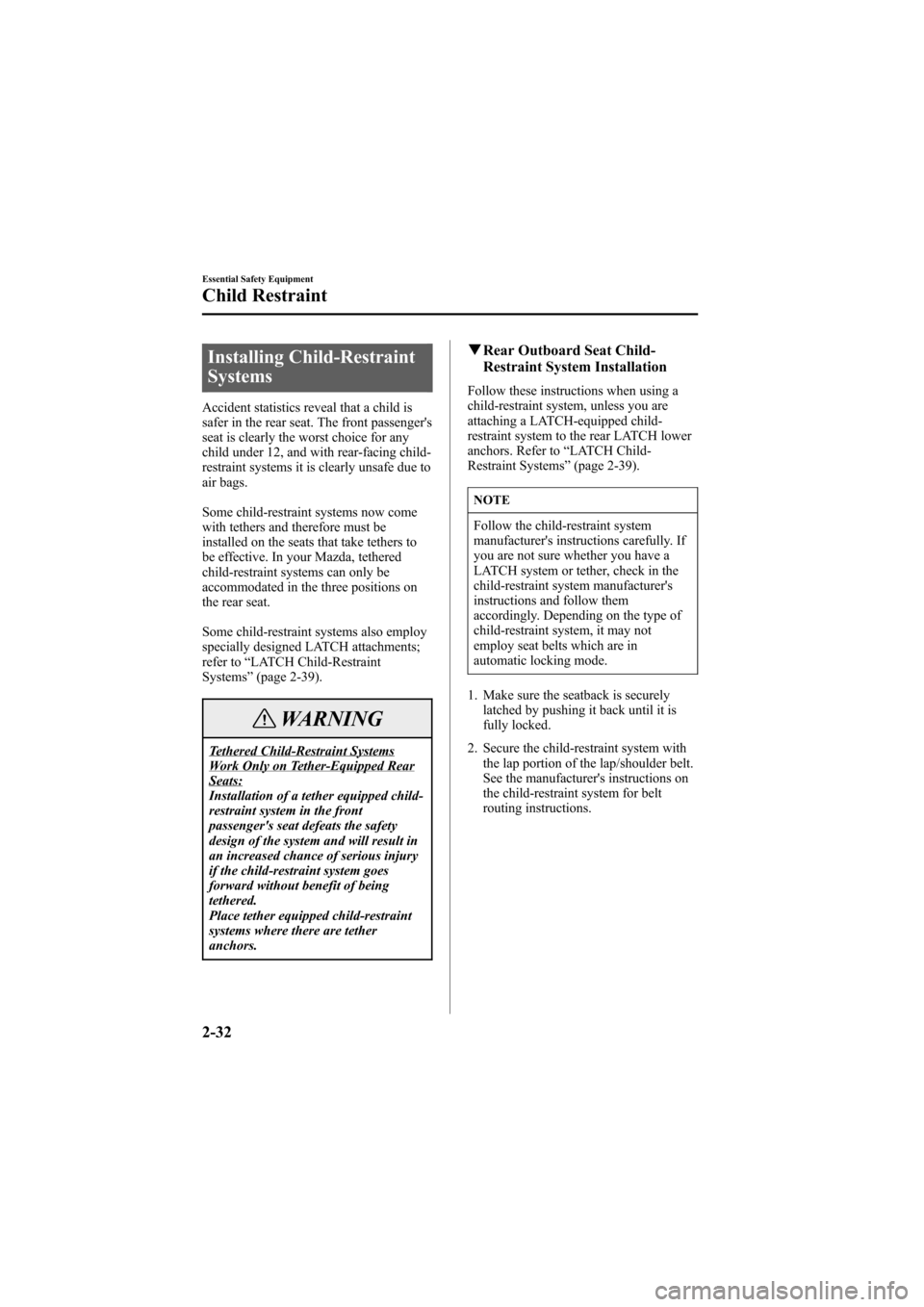
Black plate (46,1)
Installing Child-Restraint
Systems
Accident statistics reveal that a child is
safer in the rear seat. The front passenger's
seat is clearly the worst choice for any
child under 12, and with rear-facing child-
restraint systems it is clearly unsafe due to
air bags.
Some child-restraint systems now come
with tethers and therefore must be
installed on the seats that take tethers to
be effective. In your Mazda, tethered
child-restraint systems can only be
accommodated in the three positions on
the rear seat.
Some child-restraint systems also employ
specially designed LATCH attachments;
refer to“LATCH Child-Restraint
Systems”(page 2-39).
WARNING
Tethered Child-Restraint SystemsWork Only on Tether-Equipped RearSeats:
Installation of a tether equipped child-
restraint system in the front
passenger's seat defeats the safety
design of the system and will result in
an increased chance of serious injury
if the child-restraint system goes
forward without benefit of being
tethered.
Place tether equipped child-restraint
systems where there are tether
anchors.
qRear Outboard Seat Child-
Restraint System Installation
Follow these instructions when using a
child-restraint system, unless you are
attaching a LATCH-equipped child-
restraint system to the rear LATCH lower
anchors. Refer to“LATCH Child-
Restraint Systems”(page 2-39).
NOTE
Follow the child-restraint system
manufacturer's instructions carefully. If
you are not sure whether you have a
LATCH system or tether, check in the
child-restraint system manufacturer's
instructions and follow them
accordingly. Depending on the type of
child-restraint system, it may not
employ seat belts which are in
automatic locking mode.
1. Make sure the seatback is securely
latched by pushing it back until it is
fully locked.
2. Secure the child-restraint system with
the lap portion of the lap/shoulder belt.
See the manufacturer's instructions on
the child-restraint system for belt
routing instructions.
2-32
Essential Safety Equipment
Child Restraint
Mazda6_8T56-EC-04G_Edition2 Page46
Monday, November 15 2004 4:32 PM
Form No.8T56-EC-04G
Page 47 of 340
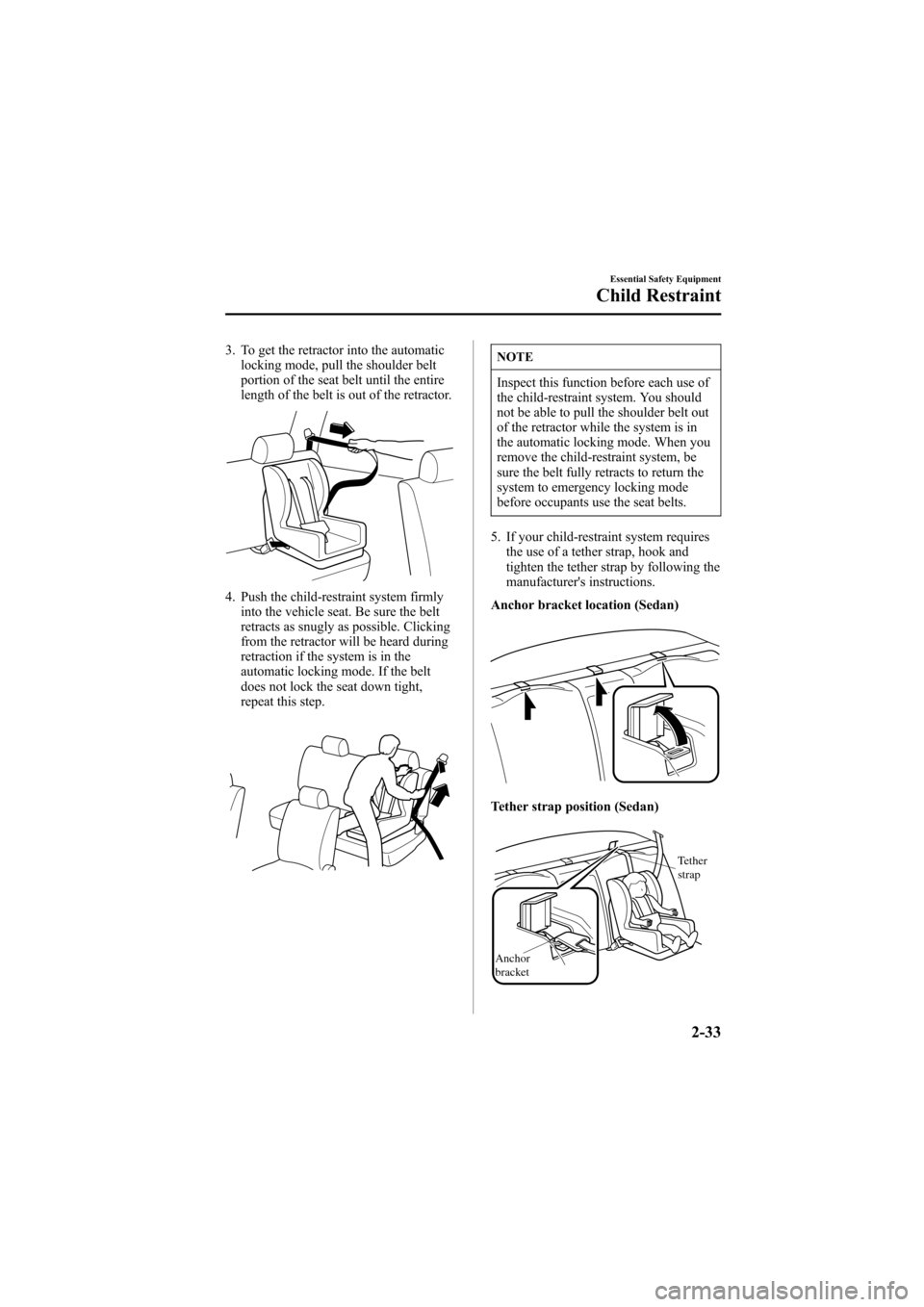
Black plate (47,1)
3. To get the retractor into the automatic
locking mode, pull the shoulder belt
portion of the seat belt until the entire
length of the belt is out of the retractor.
4. Push the child-restraint system firmly
into the vehicle seat. Be sure the belt
retracts as snugly as possible. Clicking
from the retractor will be heard during
retraction if the system is in the
automatic locking mode. If the belt
does not lock the seat down tight,
repeat this step.
NOTE
Inspect this function before each use of
the child-restraint system. You should
not be able to pull the shoulder belt out
of the retractor while the system is in
the automatic locking mode. When you
remove the child-restraint system, be
sure the belt fully retracts to return the
system to emergency locking mode
before occupants use the seat belts.
5. If your child-restraint system requires
the use of a tether strap, hook and
tighten the tether strap by following the
manufacturer's instructions.
Anchor bracket location (Sedan)
Tether strap position (Sedan)
Anchor
bracketTether
strap
Essential Safety Equipment
Child Restraint
2-33
Mazda6_8T56-EC-04G_Edition2 Page47
Monday, November 15 2004 4:32 PM
Form No.8T56-EC-04G
Page 48 of 340
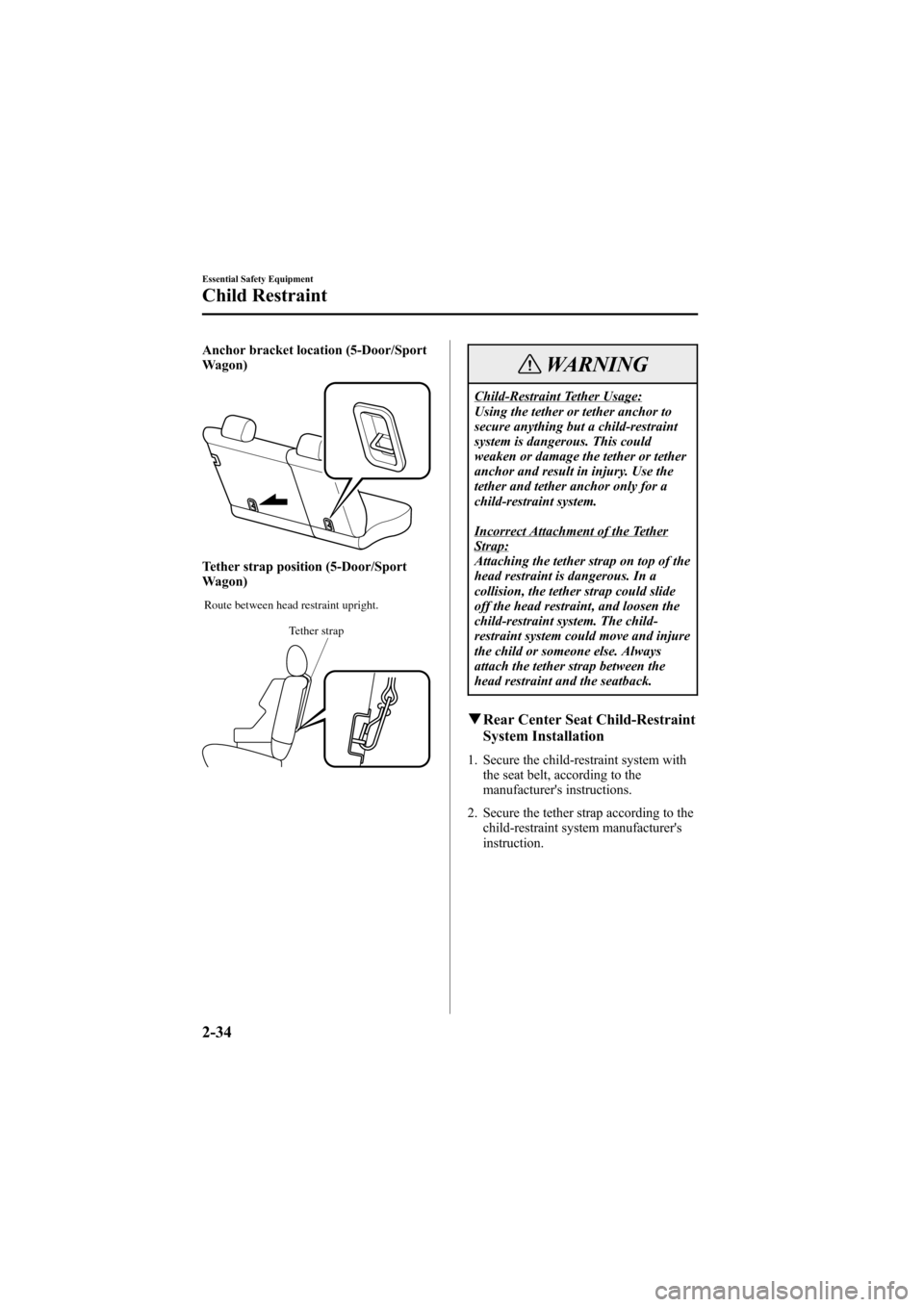
Black plate (48,1)
Anchor bracket location (5-Door/Sport
Wagon)
Tether strap position (5-Door/Sport
Wagon)
Tether strap Route between head restraint upright.
WARNING
Child-Restraint Tether Usage:
Using the tether or tether anchor to
secure anything but a child-restraint
system is dangerous. This could
weaken or damage the tether or tether
anchor and result in injury. Use the
tether and tether anchor only for a
child-restraint system.
Incorrect Attachment of the TetherStrap:
Attaching the tether strap on top of the
head restraint is dangerous. In a
collision, the tether strap could slide
off the head restraint, and loosen the
child-restraint system. The child-
restraint system could move and injure
the child or someone else. Always
attach the tether strap between the
head restraint and the seatback.
qRear Center Seat Child-Restraint
System Installation
1. Secure the child-restraint system with
the seat belt, according to the
manufacturer's instructions.
2. Secure the tether strap according to the
child-restraint system manufacturer's
instruction.
2-34
Essential Safety Equipment
Child Restraint
Mazda6_8T56-EC-04G_Edition2 Page48
Monday, November 15 2004 4:32 PM
Form No.8T56-EC-04G
Page 49 of 340
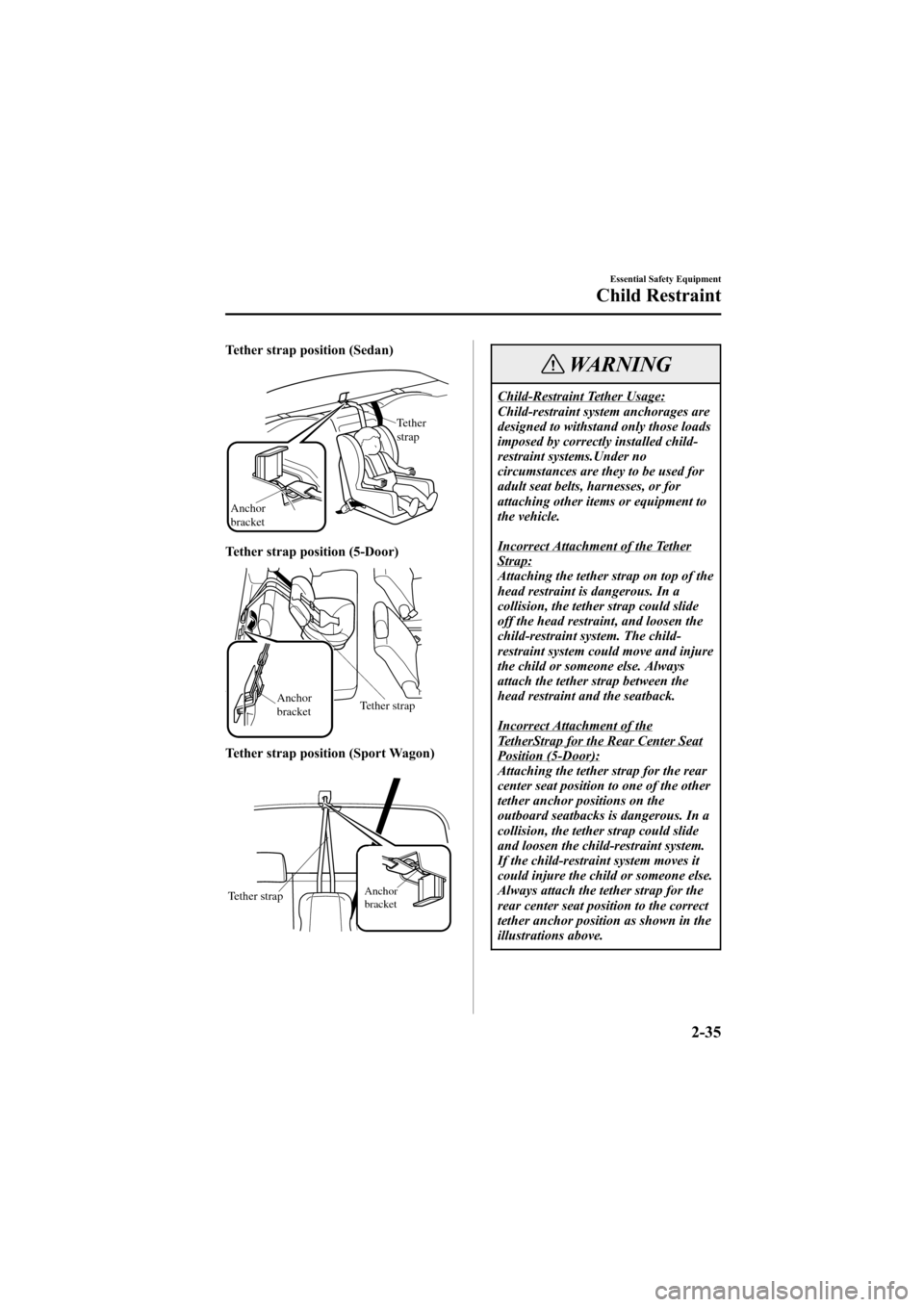
Black plate (49,1)
Tether strap position (Sedan)
Anchor
bracketTether
strap
Tether strap position (5-Door)
Tether strap Anchor
bracket
Tether strap position (Sport Wagon)
Anchor
bracketTether strap
WARNING
Child-Restraint Tether Usage:
Child-restraint system anchorages are
designed to withstand only those loads
imposed by correctly installed child-
restraint systems.Under no
circumstances are they to be used for
adult seat belts, harnesses, or for
attaching other items or equipment to
the vehicle.
Incorrect Attachment of the TetherStrap:
Attaching the tether strap on top of the
head restraint is dangerous. In a
collision, the tether strap could slide
off the head restraint, and loosen the
child-restraint system. The child-
restraint system could move and injure
the child or someone else. Always
attach the tether strap between the
head restraint and the seatback.
Incorrect Attachment of theTetherStrap for the Rear Center SeatPosition (5-Door):
Attaching the tether strap for the rear
center seat position to one of the other
tether anchor positions on the
outboard seatbacks is dangerous. In a
collision, the tether strap could slide
and loosen the child-restraint system.
If the child-restraint system moves it
could injure the child or someone else.
Always attach the tether strap for the
rear center seat position to the correct
tether anchor position as shown in the
illustrations above.
Essential Safety Equipment
Child Restraint
2-35
Mazda6_8T56-EC-04G_Edition2 Page49
Monday, November 15 2004 4:32 PM
Form No.8T56-EC-04G
Page 50 of 340
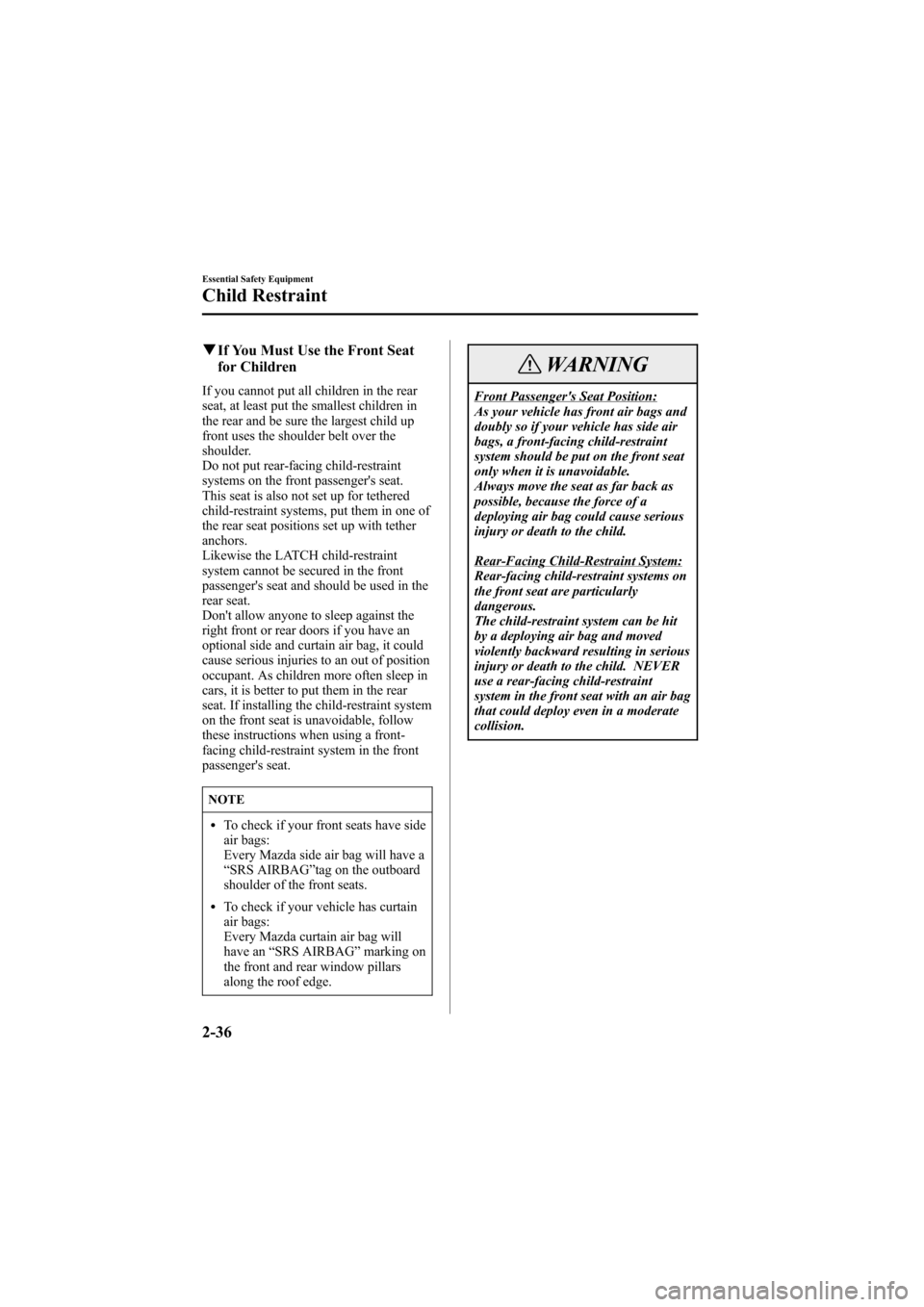
Black plate (50,1)
qIf You Must Use the Front Seat
for Children
If you cannot put all children in the rear
seat, at least put the smallest children in
the rear and be sure the largest child up
front uses the shoulder belt over the
shoulder.
Do not put rear-facing child-restraint
systems on the front passenger's seat.
This seat is also not set up for tethered
child-restraint systems, put them in one of
the rear seat positions set up with tether
anchors.
Likewise the LATCH child-restraint
system cannot be secured in the front
passenger's seat and should be used in the
rear seat.
Don't allow anyone to sleep against the
right front or rear doors if you have an
optional side and curtain air bag, it could
cause serious injuries to an out of position
occupant. As children more often sleep in
cars, it is better to put them in the rear
seat. If installing the child-restraint system
on the front seat is unavoidable, follow
these instructions when using a front-
facing child-restraint system in the front
passenger's seat.
NOTE
lTo check if your front seats have side
air bags:
Every Mazda side air bag will have a
“SRS AIRBAG”tag on the outboard
shoulder of the front seats.
lTo check if your vehicle has curtain
air bags:
Every Mazda curtain air bag will
have an“SRS AIRBAG”marking on
the front and rear window pillars
along the roof edge.
WARNING
Front Passenger's Seat Position:
As your vehicle has front air bags and
doubly so if your vehicle has side air
bags, a front-facing child-restraint
system should be put on the front seat
only when it is unavoidable.
Always move the seat as far back as
possible, because the force of a
deploying air bag could cause serious
injury or death to the child.
Rear-Facing Child-Restraint System:
Rear-facing child-restraint systems on
the front seat are particularly
dangerous.
The child-restraint system can be hit
by a deploying air bag and moved
violently backward resulting in serious
injury or death to the child. NEVER
use a rear-facing child-restraint
system in the front seat with an air bag
that could deploy even in a moderate
collision.
2-36
Essential Safety Equipment
Child Restraint
Mazda6_8T56-EC-04G_Edition2 Page50
Monday, November 15 2004 4:32 PM
Form No.8T56-EC-04G